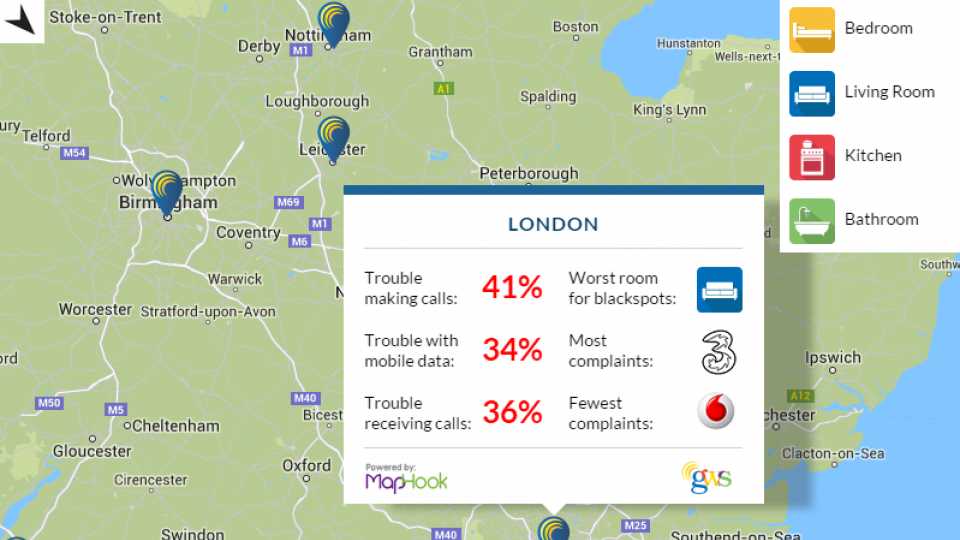40% of Britons have mobile phone blackspots in their homes, with EE and Three proving the least reliable UK networks. The data comes from a new study conducted by Global Wireless Solutions, who previously revealed the extensive blackspots affecting UK train commuters . Out of the 2,000 people polled across the country, 1 in 3 said that they "regularly" have issues making and receiving mobile calls from home, while almost 30% of people said that they regularly experience mobile internet connectivity issues at home.
The prize for worst-afflicted city goes to Liverpool, with 60% of respondents reporting mobile blackspots. Cardiff came in second with 54% of respondents reporting mobile blackspots, while third place went to Bristol with 53%. The data also found that homes built in the Georgian period are more likely to have mobile blackspots than modern homes built in the last twenty years.
As a result, GWS says 1 in 4 of UK adults polled said that their mobile data connectivity issues had "definitely contributed" to their decision to switch operators in the past, while more than 1 in 7 respondents said that voice calling blackspots had determined their decision to switch mobile service provider.
GWS also spent six weeks in April and May inside London homes with mobile network testing rigs to gather data inside and outside more than 50 homes across the capital. Rather than crowdsource the information, GWS recorded the "layer 3" network information to gain a more accurate reflection of consumers' true mobile experiences.
The data found that moving indoors had a noticeable effect on the reliability of certain UK voice networks. EE came out the worst, with 1 in 14 test calls made from EE-locked devices failing inside homes, but Three wasn't much better, with 1 in 20 test calls failing. By comparison, O2's voice network only failed 1 in 173 test calls. Vodafone also fared well, with GWS saying that only 1 in 79 calls were blocked and dropped during its tests.
"The UK is no longer a ‘fixed line’ nation," said Paul Carter, CEO of GWS. "When we’re at home we don’t just receive calls on our mobiles – we make them too. The best phone is the one you’ve got on you – not the one sitting in its dock out in the hallway. But that presents a problem for operators – many of whom are clearly struggling with the brave new world of ‘in-home mobility'. Only by gathering and analysing accurate data on the performance of wireless networks will operators find a solution that genuinely benefits consumers - consumers who are currently not well-served by the kind of ‘crowd-sourced’ data operators too-often use to bolster unrealistic claims about the level of service they offer."
Three was also one of the least reliable networks for 4G coverage. GWS found that its 4G network was covered for 78% of the time it spent testing outside properties, but was only covered 55% of the time indoors. EE, by comparison, was covered 100% outdoors, but only 85% of the time indoors. Once again, O2 and Vodafone proved to have the best in-home 4G penetration, with O2 providing 4G coverage 90% of the time indoors, while Vodafone provided coverage for 87% of the time indoors.
It should be noted, though, that both EE and Three are in the process of improving their in-home 4G coverage. EE, for example, has recently launched its Wi-Fi Calling initiative, which lets users make and take calls over their home Wi-Fi network, while Three will soon be launching its new low-frequency VoLTE service this autumn to help improve 4G penetration inside UK homes and make voice calls over 4G.
GWS's data also revealed which rooms in your home are likely to be worst affected. Out of all the blackspot-afflicted respondents polled, 2 in 3 said they had problems in their kitchen, which was supported by the data GWS collected during its research programme. More calls failed to initialise in the kitchen than in any of the other room types tested, according to GWS, which also included living rooms, bedrooms and bathrooms. Tests also revealed that the kitchen had the lowest operator 4G penetration, with only 74% reliability on average.












